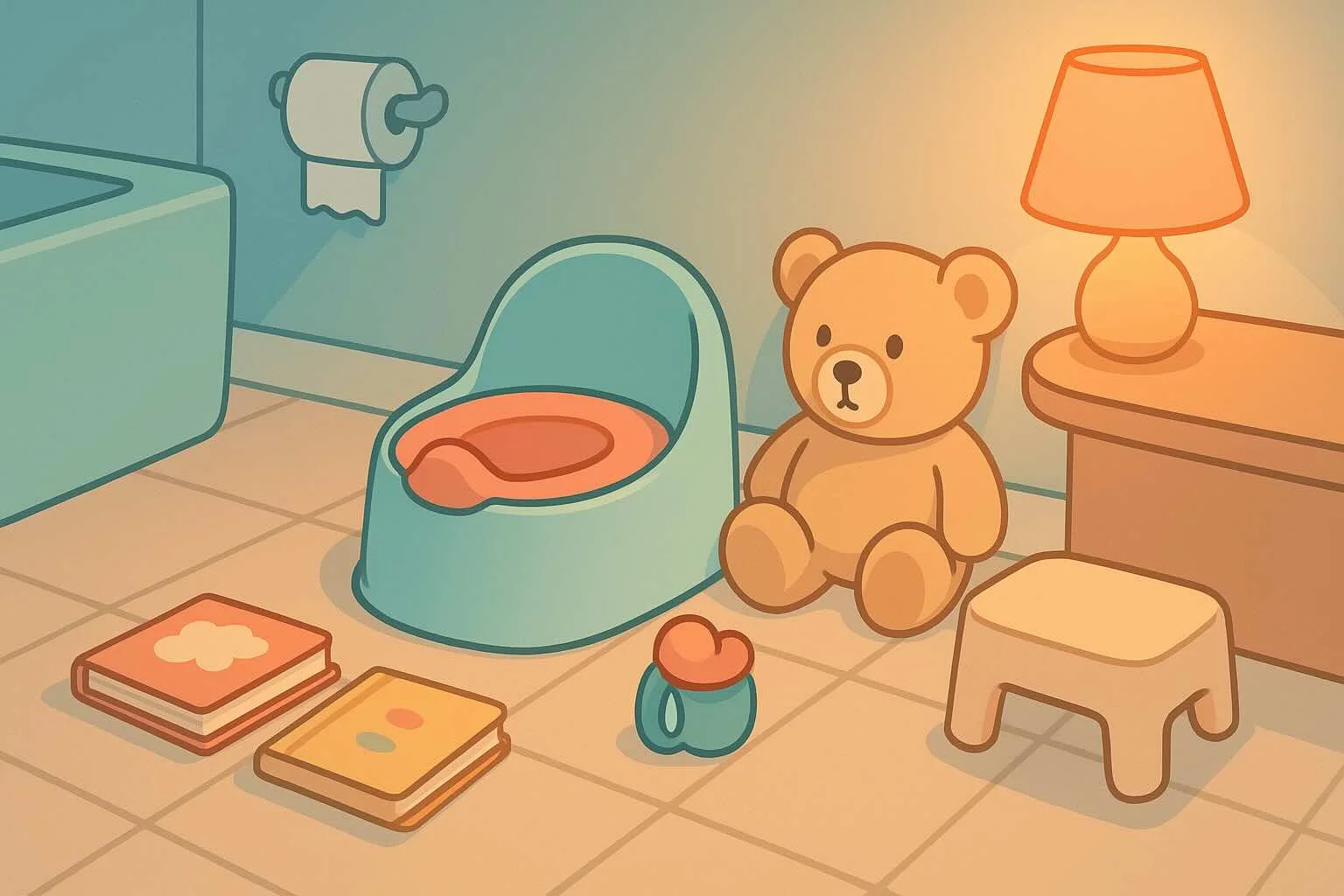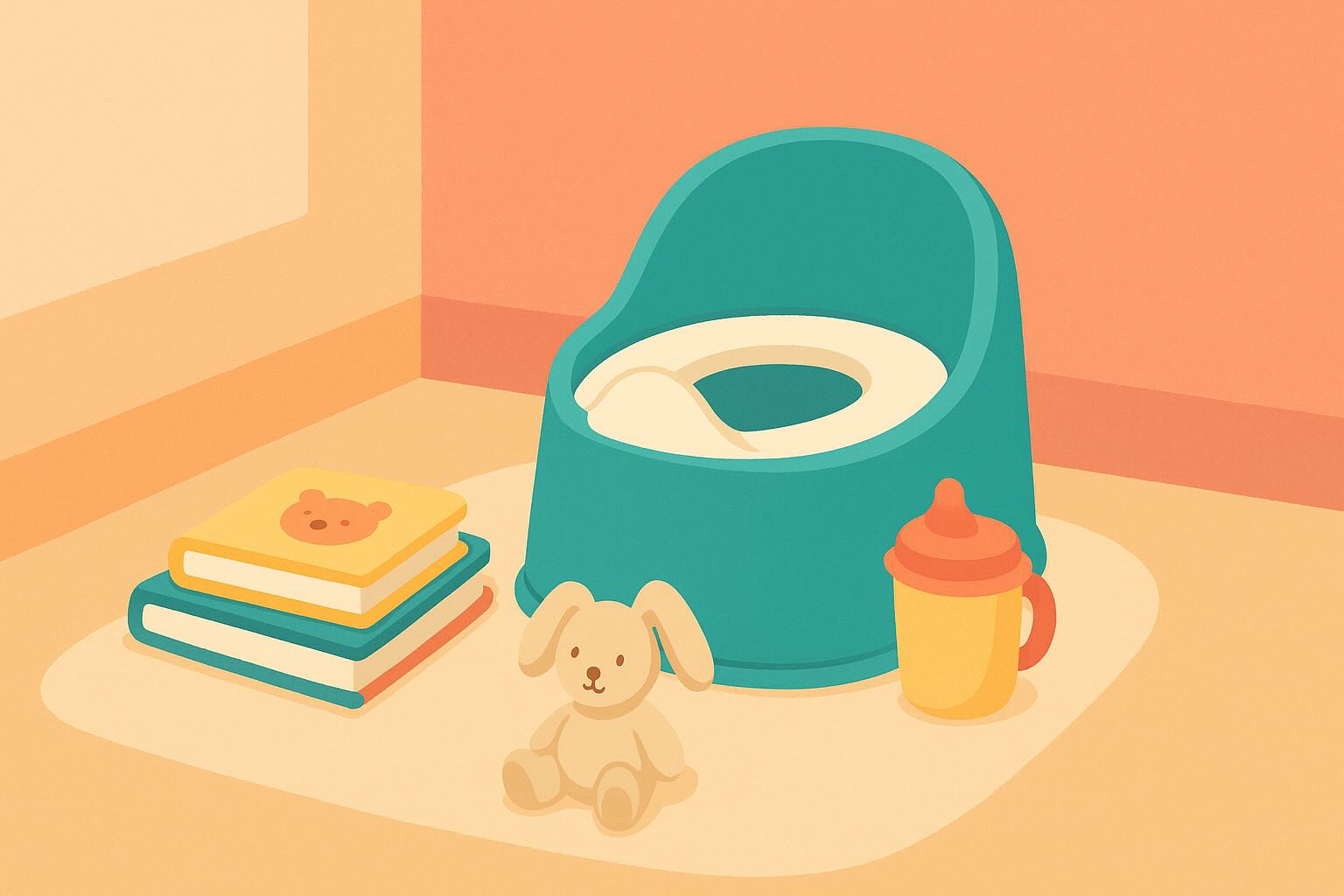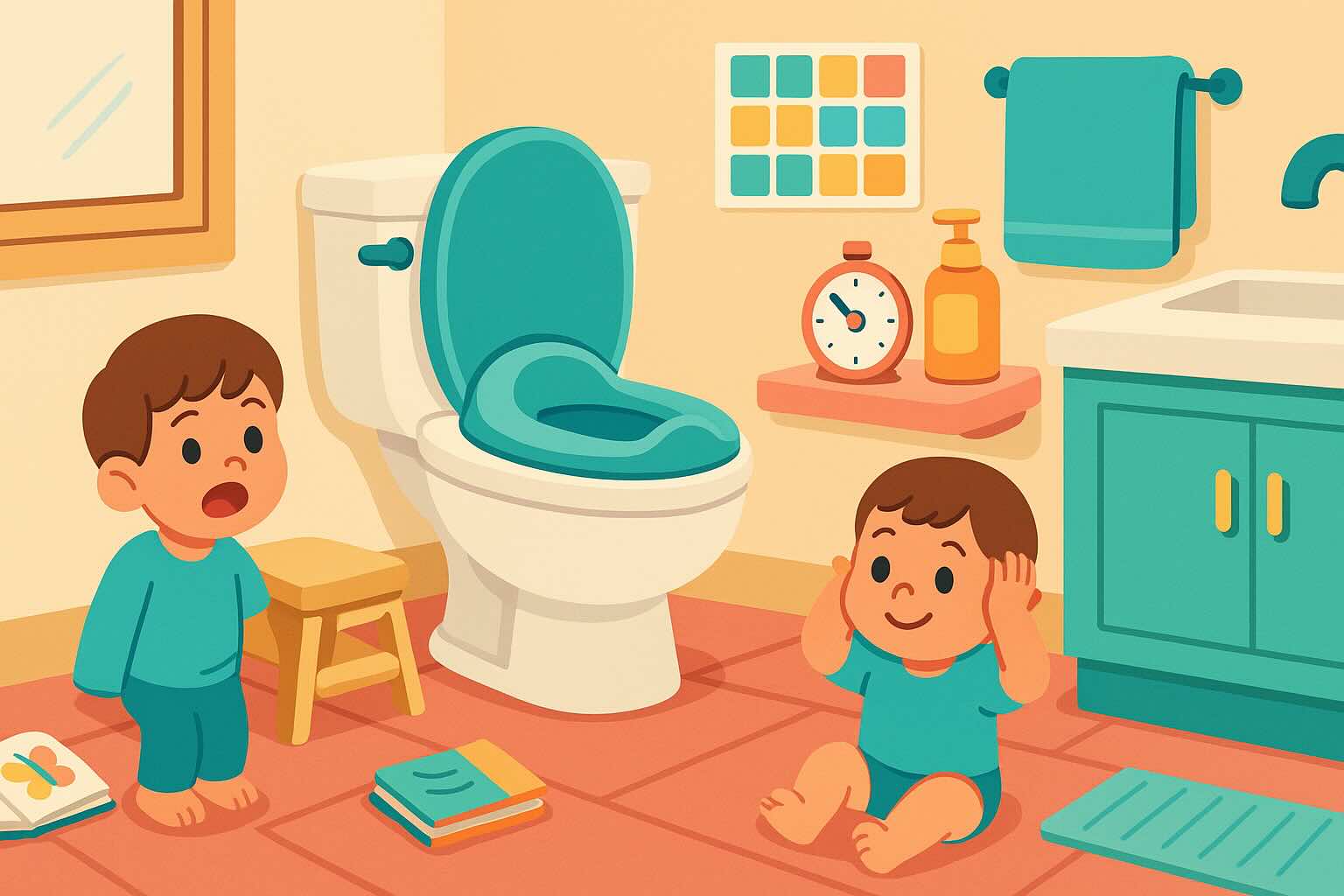Potty Learning Complete Guide: Stress-Free Method for Ages 2-4 (Works in 3-7 Days)
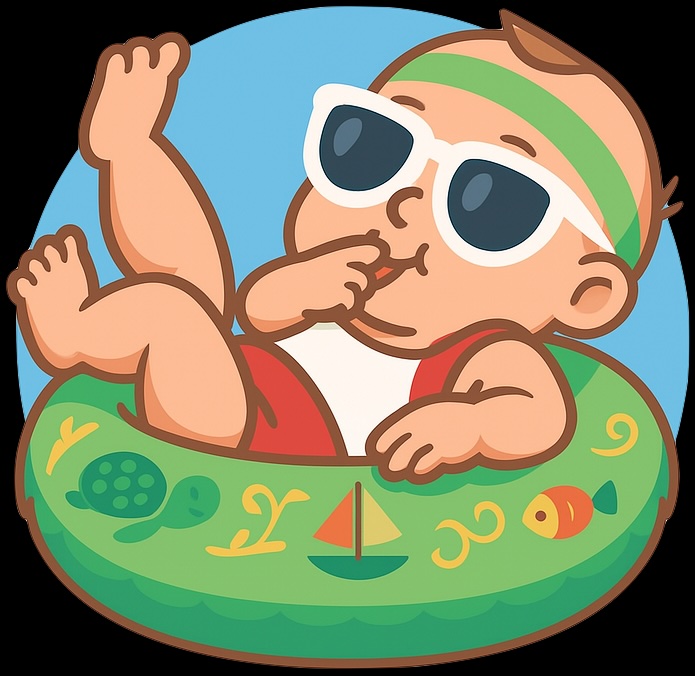
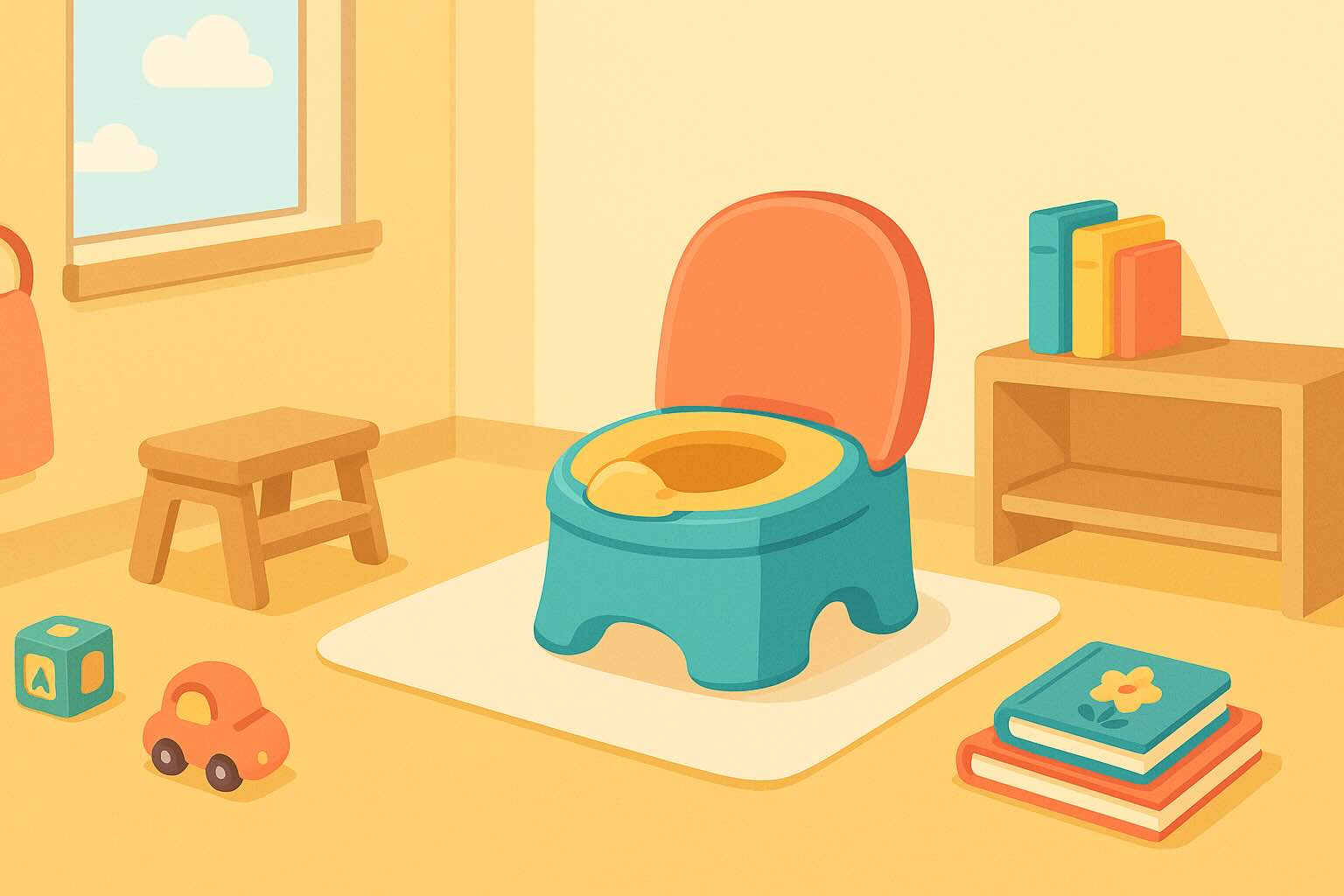
If you're dreading potty learning or feeling overwhelmed by conflicting advice, take a deep breath. This comprehensive guide provides a child-centered, stress-reducing approach that works for most families within 3-7 days, with full consistency developing over 2-4 weeks. Unlike traditional "potty training" methods that focus on adult control and rewards, our approach prioritizes your child's independence, body awareness, and emotional wellbeing.
This isn't just about getting your child out of diapers—it's about building foundational life skills including independence, body sovereignty, and self-regulation that will serve your child far beyond the potty process. For age-specific strategies, see our detailed guides for 2-year-olds, 3-year-olds, and 4-year-olds. If you're managing broader challenges like power struggles or life transitions, those resources will complement this potty learning approach.
What You'll Learn in This Guide
- Why We Say "Learning" Not "Training" - The philosophy that makes this approach successful
- 6 Readiness Signs - How to know when your child is truly ready to begin
- Parent Preparation - Critical self-reflection to manage your own triggers
- The 3-Day Intensive Method - Complete day-by-day breakdown with scripts
- Responding to Accidents - De-shaming language and productive responses
- Celebrating Success - How to acknowledge without over-praising
- Poop Anxiety Solutions - Addressing the most common and stressful challenge
- Age-Specific Strategies - Different approaches for 2, 3, and 4-year-olds
- Common Scenarios - Travel, public bathrooms, regression, and more
- Realistic Timeline - What to expect week by week during the process
Estimated reading time: 12 minutes
Why "Potty Learning" Instead of "Potty Training"?
The Philosophy That Changes Everything
The words we use matter. "Training" implies that adults control and shape a child's behavior through direction and rewards—essentially teaching a child to perform on command. This outcome-focused approach creates stress, power struggles, and often backfires.
"Learning" recognizes that this is your child's process, not yours. Your role is to support, not direct. Your child is learning to:
- Recognize sensations in their own body
- Understand what those sensations mean
- Make independent decisions about their bodily functions
- Trust their own body's signals
This process-oriented approach focuses on what's happening inside your child (building body awareness) rather than just observable behaviors (staying dry). Research shows that when children feel in control of this process, they're more successful both short-term and long-term.
Five Foundational Life Skills You're Building
Potty learning isn't just about bathroom independence—it's simultaneously developing critical life skills:
1. Independence: Your child practices doing things on their own, building confidence in their capabilities.
2. Separation: This represents a developmental milestone of growing up and separating from parental care, as your child moves from diaper changes (connection time) to independent bathroom use.
3. Control: Your child learns that they're in charge of their own body—a foundational lesson in agency and autonomy.
4. Body Awareness: Recognizing internal sensations and assigning meaning to them builds the foundation for emotional regulation, hunger/fullness cues, and overall body literacy.
5. Body Sovereignty: This is the ultimate goal—your child internalizes that they are the only one in their body, they're the only one who knows how they feel, and they're the only one who makes decisions about their body. This foundation supports self-confidence, boundary-setting, consent, and healthy relationships throughout life.
Acknowledgment: The framework of five foundational life skills (independence, separation, control, body awareness, and body sovereignty) is inspired by Dr. Becky Kennedy's Good Inside approach to child development. We've expanded this framework with age-specific strategies, practical scripts, and scenario-based guidance to support parents through the complete potty learning journey.
Your mantra for this process: My child will figure this out. I'm here to support, not control or take over.
6 Signs Your Child Is Ready to Begin
Reading Your Child's Readiness Cues
There is no magic age for potty learning. While many children show readiness between 2-3 years, this varies enormously. Some children are ready at 20 months; others at 3.5 years. The key is observing your child's signals, not comparing to other children or following arbitrary timelines.
Before we go further, ground yourself in this truth: There's no right age for potty learning. I'm not going to mess this up. I am capable, my child is capable, and no one knows my family better than I do.
Look for these 6 readiness signs (your child doesn't need all of them):
Sign 1: Following Simple Directions Your child can follow 1-2 step commands like "Please put your cup on the table" or "Come to the bathroom with me." Potty learning involves multiple steps, so this basic skill helps set them up for success.
Sign 2: Staying Dry for Extended Periods You notice your child's diaper stays dry for at least 2 hours at a time, or they wake from naps with a dry diaper. This shows developing bladder control and the physical ability to "hold it."
Sign 3: Curiosity About Bathroom Activities Your child wants to follow you to the bathroom, asks questions about the toilet, or shows interest in potties. This behavioral cue indicates readiness to learn.
Sign 4: Discomfort When Wet or Dirty Some children (not all) start protesting when they have a wet or soiled diaper. While not required for readiness, this signals growing body awareness.
Sign 5: Understanding Body Part Words Your child knows and uses anatomically correct words like penis, testicles, vulva, vagina, and anus. Using real words (not euphemisms) builds comfort with their body and sets the stage for body sovereignty.
Sign 6: Seeking Independence You notice your child wanting to do things themselves: "I want to feed myself," "I'll climb into my chair," "I can put on my shoes." These independence behaviors signal developmental readiness for potty learning.
What Is NOT a Sign of Readiness
Don't start potty learning because:
- Your friend's child is already trained
- A book told you it's time
- You feel anxious or worried about the timeline
- You were potty trained at this age
- Your other child was ready at this age
- Family members are pressuring you
If your child isn't showing readiness signs, that's completely normal. More preparation time is never wasted. Use the upcoming months to build body awareness, model the bathroom process, and create positive associations with potties.
Parent Preparation: The Missing Piece Most Approaches Skip
Why Your Own Triggers Matter More Than You Think
Here's an inconvenient truth: How potty learning unfolds in your family has as much to do with your triggers as with your child's readiness. Most potty learning advice focuses exclusively on the child, but your own relationship with control, mess, mistakes, and separation shapes the entire process.
Take 5 minutes right now for honest self-reflection. These questions will help you prepare emotionally:
Question 1: How am I when I'm invested in something but it's somewhat outside my control?
Think about being stuck in traffic when you're already late. What sensations come up in your body? What thoughts run through your mind? Those same feelings and thoughts will likely surface during potty learning, because you want your child to succeed but you can't control when they pee.
The practice: Notice these "not in control" feelings now. The more you befriend these feelings in advance, the less hold they'll have over you. Say out loud: "Hello, frustration. Hello, anxiety. You'll probably visit during potty learning, and that's okay."
Question 2: How do I react to mistakes and struggles?
When you're working toward a goal and there's a setback—maybe a work project hits an obstacle or you burn dinner—how do you respond internally? Do you catastrophize? Become frustrated with yourself? Stay calm and problem-solve?
Your pattern around mistakes will show up when your child has accidents. Knowing your pattern now helps you respond more intentionally then.
Question 3: How am I with mess?
Do you prefer your home tidy and organized? Does disorder make you anxious? How do you feel when your child comes home muddy from the park?
There's no better or worse answer here—just self-awareness. If you know mess triggers you, you can prepare grounding exercises to use when accidents happen.
Question 4: How am I with allowing my child to separate from me?
Potty learning represents a distinct moment when your child grows up and separates from you. It's normal for big feelings to surface—not just about the potty, but about what it represents: your child getting older, needing you less, becoming more independent.
What comes up for you when you imagine your child not needing you for this anymore?
Question 5: Visualization Practice
Close your eyes and picture your child having just peed all over your carpet. Really visualize it: the puddle, the carpet, your child standing there.
What do you notice? What do you want to say? How do you feel toward your child in that moment?
Now, ground yourself: Press your feet firmly into the floor. Take a deep breath. Tell yourself: My child will figure this out. I'm here to support, not control or take over.
This visualization just began building the neural pathway you'll need during actual accidents. The more you practice this grounding now, the more automatically it will come when you need it.
Common Parental Triggers & How to Manage Them
Trigger: "My child is peeing for attention/on purpose"
Reframe: Ask yourself the most generous interpretation. If your good-inside child is doing this, what might they be trying to communicate? Often this signals anxiety about a big change (new sibling, new job schedule, move). The "misbehavior" is actually a bid for connection and reassurance.
Trigger: "Everyone else's child is already trained"
Reframe: Social comparison helps no one. Repeat: No one outside my family knows my child better than I do. I don't have to prove anything to anyone. I don't need anyone else to agree with my timeline.
Trigger: "What if they never figure this out?"
Reframe: Notice the "fast-forward thought"—you're imagining your child at 5, 8, or 21 still in diapers. Come back to today. Say the actual date and your child's actual age out loud. Then: My child's struggles today are not predictive of struggles months or years from now. I can cope with today.
The 3-Day Potty Learning Method: Complete Implementation Guide
Shopping List & Setup (Do This First)
Essential supplies:
-
Potties (2-3 recommended): Get child-sized potties that sit on the floor rather than toilet seat inserts. Why multiple? If your child has to run upstairs to the only potty, distance can interfere with success. Place one in the bathroom and one or two in spaces where your child spends time.
-
Underwear (15-20 pairs): Involve your child in choosing undies about a week before you start. Make it exciting: "You're going to be done with diapers soon! Let's pick out your special undies together."
-
Pull-ups (1-2 packs): ONLY for sleep. Never call these diapers—call them "sleep undies" or "nighttime undies." Nighttime dryness is biologically driven and not part of active potty learning.
-
Extra fluids: Stock up on your child's favorite drinks. More liquid input means more practice opportunities recognizing the urge to pee.
-
Optional cleaning supplies: Enzymatic cleaner for carpet accidents, extra towels, waterproof mattress protector.
Timeline: Finding Your 3-Day Window
Look at your calendar and find 3 consecutive days where you can:
- Stay mostly at home
- Cancel major plans and commitments
- Minimize transitions and distractions
- Focus primary attention on your child
Best timing: Long weekends, vacation days, or any stretch without preschool/daycare. Avoid timing around major life transitions (moving, new baby arriving, starting school) if possible.
The night before Day 1: Share this with your child during a calm moment (not at bedtime when they're tired):
"Tomorrow is a special day. You're going to learn how to pee and poop on the potty. You're so ready! Learning new things can be exciting and sometimes a bit tricky, and I'll be right there with you."
If you sense resistance: "You're not so sure? That makes sense—new things can feel uncertain. Let's see how it feels in the morning. You know yourself best."
If your child expresses strong resistance in the morning, pause. Don't force the process. Return to preparation activities and try again in a few weeks.
Day 1: The Foundation Day
Morning Wake-Up
Start the day with enthusiasm but stay calm:
"Today's the day! Let's take off that diaper. You get to be naked from the waist down today while you learn to pee and poop on the potty."
Being naked eliminates the step of removing underwear, making success more likely. If your child insists on wearing undies, allow it—remember, they need to feel in control.
Setting Clear Expectations
Explain what's different now:
"This is different from diapers. Now we pee and poop on the potty. I know you'll figure this out. Your job is to pay attention to your body and let me know when you have that 'I need to go' feeling. When you feel it, we'll run to the potty together and get as much pee or poop in there as we can."
Modeling the Process
Do this early on Day 1. Go to the bathroom yourself and narrate out loud:
"Oh, I think I'm having that feeling. Hmm, is it? Not quite sure yet. I think it is... yes, I'm pretty sure. I'm going to walk to the bathroom now. Let me sit down here... [count to 15 silently]... [take an audible deep breath]... ahhh, that feels good!"
Then, 5-10 minutes later, model hesitation:
"Oh, I might have that feeling again. But I'm playing with you—this is so fun. Maybe it's not that strong yet. Hmm... Actually, I can stop playing and come back. I'll go use the toilet and then play again."
This modeling is powerful because it shows the entire arc your child needs to learn: noticing a sensation, questioning it, deciding to act, pausing an activity, going to the bathroom, and returning to the activity.
Staying Close and Watching for Cues
Stay physically near your child throughout Day 1. Watch for signs they might need to go (holding genitals, wiggling, sudden stillness, grimacing). When you notice, try:
- "Do you want to try going to the potty together?"
- "I'm going to check in with my own body right now. Do you want to try too?"
- "I'm wondering if you have that feeling. Let me know if you do!"
Never say: "I know you have to go," "You need to pee," or "Come sit on the potty now." These statements take control away from your child.
Handling First Accidents
Accidents will happen on Day 1. Stay calm. Describe matter-of-factly without personalizing:
"Your legs are wet. Let's dry you off and get fresh undies." or "There's pee on the floor. Let's clean it up together. Bodies are learning what that feeling means before the pee comes out."
Link back to body awareness:
"Next time that feeling comes, you'll catch it. You're learning."
Evening Routine: Introducing Sleep Undies
Before nap and bedtime, introduce pull-ups as "sleep undies":
"For sleeping, you wear special sleep undies because your body is learning the daytime potty stuff first. Night learning happens on its own—you don't have to do anything!"
Day 2: Building on Day 1
Reducing Prompts, Increasing Independence
Continue the same approach from Day 1, but with these adjustments:
- Give fewer check-in prompts
- Let your child initiate more often
- Notice and acknowledge any increase in awareness: "I noticed you stopped playing and looked at your body. You're really tuning in!"
- Keep modeling occasionally
- Maintain staying mostly at home
If Accidents Continue
That's completely normal. Keep providing fluid, keep responding calmly, keep building body awareness. Avoid any hint of disappointment—remember, you're teaching them to tune into internal sensations, which is an invisible, complex skill.
If Successes Are Increasing
Acknowledge simply. Count to 15 before saying anything (this lets your child own their success first). Then: "You had the feeling, and you got to the potty!" That's it. No "I'm so proud!" or "Good job!"—just noticing what happened.
Day 3: Beginning Independence
If Your Child Is Making Progress
Consider these next steps:
- Try a short outing (15-30 minute walk, trip to nearby park)
- Use the potty before leaving
- Stay close to home in case you need to return quickly
- Bring spare undies and pants
- Remind before leaving: "We're going out. If you have the potty feeling, tell me and we'll come home fast"
If Your Child Is Still Struggling
Continue the Day 1 and Day 2 approach:
- Stay home
- Maintain the same calm, supportive responses
- Reflect on potential issues: Is your child resisting control? Anxious about the potty? Dealing with life stress? Not quite ready developmentally?
Sometimes the best response is taking a 1-2 week break and starting fresh.
Responding to Accidents: The Art of De-Shaming
Your Core Mantra
Repeat this until you believe it: Accidents are part of the process. Accidents happen on the pathway to success. My child has got this.
Accidents aren't failures—they're critical learning opportunities. When your child feels pee running down their leg, their brain is making connections: "Oh, THAT feeling that happened before the pee—that's the signal I'm learning to recognize."
Scripts for Accident Responses
When pee/poop happens on the floor or in undies:
Don't say:
- "Oh, again?"
- "You could have made it to the potty!"
- "You're just not getting it"
- "Why didn't you tell me?"
Instead, say:
- "Your undies are wet. Let's get you dry ones."
- "There's pee on the floor. Bodies are learning."
- "Let's keep watching for that feeling. It's tricky to learn."
- "Next time that feeling comes, you'll catch it a bit earlier. You're working at this, I can see it."
When your child has an accident and seems upset:
"Learning new things is hard. You're still figuring out what that feeling is before the pee comes. That's okay—you're learning."
When you feel yourself getting triggered:
- Take a deep breath
- Press your feet into the ground
- Remind yourself: This is temporary. My child is learning. I can cope with this moment.
- If needed, excuse yourself briefly: "I need to take a quick breath. I'll be right back to help you."
Remember: Your calm response teaches your child that mistakes are safe, normal parts of learning. Your triggered, frustrated response teaches them shame, which actively interferes with learning.
Celebrating Success: How to Acknowledge Without Over-Praising
Why Over-Praising Backfires
When parents shower children with excessive praise for potty success—"You're such a big kid! I'm SO proud! You're amazing!"—it accidentally communicates that this matters more to the parent than the child. This adds pressure and shifts the process from the child's ownership to performing for parental approval.
For children who are naturally rebellious or strong-willed, they'll smell the control in your excitement and may resist purely to reclaim autonomy.
Better Responses to Success
When your child successfully pees or poops on the potty:
-
Count to 15 silently before saying anything. This gives your child space to own their reaction first and prevents you from jumping in with your adult excitement.
-
Keep it simple and descriptive:
- "You peed on the potty."
- "You had the feeling, it came, and you got to the potty."
- "You did that."
-
Reflect on the process, not the outcome:
- "You're really getting to know your own body."
- "You're learning what those feelings mean."
- "You're figuring this out."
-
Sometimes say nothing at all. After your 15-second count, you may notice your child already moved on and doesn't seem to want your input. That's perfect—let them own the experience fully.
What About Rewards and Sticker Charts?
Many popular approaches recommend M&Ms, stickers, or small toys for potty success. While these can work short-term for some children, they typically:
- Obscure the core message of body sovereignty
- Shift motivation from intrinsic to extrinsic
- Lead to negotiation battles
- Undermine the child's sense of being in control of their own body
If you want to use small rewards: Go ahead if it feels right for your family. You're not "doing it wrong." Some children respond well to this, especially if introduced minimally. Just recognize that intrinsic motivation—your child feeling proud of their own capability—is more sustainable long-term.
Alternative to material rewards: Do something silly and joyful together. Roll on the floor being ridiculous, do a silly dance, make funny faces. This creates a moment of connection and fun without turning potty use into a transaction.
Addressing Poop Anxiety: The Most Common and Stressful Challenge
Why Poop Is Different (And Harder) for Many Children
At potty learning ages, children are deeply concerned with body continuity—the idea that their body will stay whole and safe even as it changes. This explains why a small scrape can cause major distress: young children genuinely worry, "Is my body breaking? Will it stay whole?"
Poop anxiety stems from this same concern. When a child sees poop in the potty, it can look like a body part that separated from them. Understandably, they think: "Wait, is that part of me? Should I have let it go? Is my body still safe and whole?"
Then the adult flushes it away, which can be genuinely frightening: "A part of me just disappeared down a hole!"
This anxiety is developmental and normal. Your response makes all the difference.
6 Strategies for Poop Withholding and Anxiety
Strategy 1: Ground Yourself in the Present Moment
When you notice your child struggling with poop, you probably have a "fast-forward thought": imagining them at 5, 8, or even 21 still unable to poop. This thought creates panic that bleeds into how you respond today.
Right now, say out loud:
- Today's date
- Your child's age
- "My child's struggles today are not predictive of struggles months or years from now. Come back to today. Come back to today. I can cope with today."
Strategy 2: Build Body Continuity Understanding
Help your child understand that poop is "extra stuff" the body doesn't need—not a body part breaking off.
Script: "Your body is so smart! When you eat food, your body takes out all the good stuff it needs for energy—kind of like how a gas station gives gas to a car so it can go. Then your body figures out what's extra, what it doesn't need. Pee is extra liquid. Poop is extra food. Your body gets rid of what's extra, and your body stays whole and safe and healthy!"
Add playfulness with "the story of poop": "After we flush, poop swims down a little river to meet its friends. Bye, poop! Have fun with your friends!"
Model this yourself: When you flush, say cheerfully, "Bye, poop! Thanks for leaving my body!"
Strategy 3: Use Your Mantra to Build Your Confidence
Daily, tell yourself—write it down, say it out loud, put it on a sticky note:
"Yes, my child is struggling, AND yes, my child will figure this out."
You must believe in your child's ability to change before they can make the change themselves. Your confidence becomes their confidence.
Strategy 4: Express Your Frustrations Away From Your Child
It's normal and valid to feel frustrated when your child withholds poop for days. Don't suppress this—it just makes you more likely to leak frustration onto your child.
Instead, find a private space (closet, car, bathroom when no one's home) and let it out physically: scribble frantically, punch a pillow, say curse words out loud, yell into a towel. Get the frustration OUT so you don't bring it to the potty process.
Strategy 5: Help Your Child Build Tolerance for Mess and Release
Children who are naturally tidy, controlled, or "holding it all together" often struggle most with poop because pooping is messy and involves letting go.
Activities to build "mess tolerance":
- Have silly dance parties where everyone lets loose and moves wildly
- Play in mud, finger paint, make slime—get messy and celebrate it
- Let the playroom stay messy overnight: "We don't always need things perfect and tidy. We can still be us when there's some mess."
These activities teach a deeper message: It's okay to have parts of you that are messy, imperfect, and not neatly tied up. This directly supports comfort with pooping.
Strategy 6: Let Your Child Set the Pace (Gradual Desensitization)
If your child is terrified of pooping on the potty, don't force it. Instead, create a slow, pressure-free progression:
- Let them poop in a diaper in their bedroom (removes pressure)
- After a few days, have them poop in a diaper while in the bathroom
- Then poop in a diaper while touching the potty
- Then sitting on the potty fully clothed with a diaper on
- Then sitting on the potty with a diaper that has a small hole in it
- Then on the potty without a diaper
Each step might take days or even a week. That's okay. The slower you go, the more sustainable the success.
Most Important Reminder About Poop Anxiety
Visible, observable change takes longer than we want. If you're frustrated two weeks in, that's normal. Most poop anxiety resolves over 3-6 weeks when you stay the course with these strategies.
Your child will figure this out. I promise.
Age-Specific Strategies: 2, 3, and 4-Year-Olds
Ages 2-2.5: Early Starters
Developmental reality: Limited language, high need for routine, intense separation anxiety.
Strategies that work:
- Use very simple language (2-4 words maximum)
- Rely heavily on physical comfort and parental presence
- Create extremely consistent routines
- Use lots of visual cues (pictures, demonstration)
- Consider whether earlier is actually easier for your child or just more convenient for you
Potential challenges: Communication limitations can increase frustration for both child and parent. Be realistic about whether early starting will actually reduce total time spent or just spread it over more months.
For detailed guidance, see our complete 2-year-old potty training guide.
Ages 2.5-3: The Sweet Spot
Developmental reality: Peak readiness window for many children. Growing language, increasing independence drive, developing body awareness.
Strategies that work:
- Offer choices to honor growing autonomy: "Red undies or blue undies today?"
- Use "when/then" statements: "When you try the potty, then we can go to the park"
- Explain simply why: "Pee goes in the potty now that you're getting bigger"
- Create "yes" spaces where they have control
Potential challenges: This is peak tantrum age, so expect emotional intensity. Tantrum management strategies will help alongside potty learning.
For complete strategies, see our 3-year-old potty training guide.
Ages 3.5-4+: Later Starters
Developmental reality: Advanced language and reasoning, potential shame about being "behind" peers, possible preschool pressure, strong-willed testing.
Strategies that work:
- Use their reasoning skills: "Your body makes pee all day long. The potty is where pee goes now."
- Address any shame directly: "Different kids are ready at different times. There's no right or wrong time. You're ready now."
- Involve them in problem-solving: "What would help you remember to listen to your body?"
- Use their advanced language to talk through fears and resistance
Potential challenges: If preschool has a potty requirement and your child isn't ready, you're in a tough spot. Advocate for your child's developmental timeline, but also prepare yourself emotionally to do your best within the constraint.
For detailed strategies, see our 4-year-old not potty trained guide.
Common Scenarios & Practical Solutions
Travel and Outings
Car rides: Bring a travel potty (the kind that folds up). Have your child try before leaving. Stop every 60-90 minutes for potty breaks. Never revert to diapers during the day—this confuses the message.
Public bathrooms: Some children find public toilets scary (loud flushing, automatic features, height). Prepare by:
- Describing what they'll experience beforehand
- Offering to cover the auto-flush sensor
- Bringing a folding potty seat if your child is small
- Modeling: "I was nervous about this bathroom too. The toilet is safe. I can sit on it. I'm safe."
For complete travel strategies, see our potty training travel guide.
Regression After Success
Common triggers: New sibling, moving, starting school, parental stress, illness, developmental leaps.
Response: Assess whether to take a complete break (return to diapers temporarily) or continue with extra support. Most regressions resolve in 2-4 weeks when you address underlying stressors and reduce pressure.
For detailed regression support, see our potty training regression guide.
Nighttime Dryness
Remember: This is biological and not teachable. Most children stay dry during naps by age 3, with nighttime dryness developing naturally by age 5-7. Some children aren't dry at night until age 8-9.
What to do: Use pull-ups at night, assess by checking if they're dry for 3+ consecutive mornings, then try undies at night. If accidents return, go back to pull-ups without shame.
For complete nighttime strategies, see our nighttime potty training guide.
Realistic Timeline: What to Expect Week by Week
Week 1: Intensive Learning Phase
Day 1-3: Following the 3-day method above. Expect lots of accidents, some successes, and emotional ups and downs (for both of you).
Day 4-7: Continue consistency. Accidents should decrease but still happen. Your child's awareness is building even when it doesn't show yet behaviorally.
Your focus: Stay calm, stay consistent, keep responding the same way to accidents and successes.
Week 2-3: Consolidation Phase
Most children show significant improvement during this window if they were truly ready. You'll notice:
- Longer stretches of dryness
- Proactive communication about needing to go
- More confidence and less hesitation
- Potential increase in poop withholding as that anxiety surfaces
Your focus: Maintain consistency, address poop anxiety if it appears, slowly expand outings and normal life.
Week 4+: Maintenance Phase
By one month, most ready children are mostly reliable during waking hours with occasional accidents during:
- High excitement
- Deep focus/play
- Transitions
- Stress or illness
This is normal and expected. Full, rock-solid consistency typically develops over 2-3 months.
Your focus: Stay responsive and blame-free during remaining accidents. Continue building independence.
When to Seek Professional Help
Concerning Signs That Warrant Consultation
Contact your pediatrician if:
- Your child shows no interest in potty learning by age 4
- Persistent pain, fear, or distress around bowel movements
- Chronic constipation or withholding for more than 5-7 days
- Urinary tract infections (UTIs) occur repeatedly
- Significant regression lasting more than 2-3 months after prior success
- Your child is distressed about potty learning and it's affecting daily functioning
- Other developmental concerns alongside potty struggles
Types of professional support available:
- Pediatricians: Rule out medical causes, assess developmental appropriateness
- Child psychologists: Address anxiety, trauma, or behavioral resistance
- Occupational therapists: Help with sensory processing issues, coordination
- Pediatric gastroenterologists: Address chronic constipation and poop withholding
Trust your gut: If something feels off beyond normal potty learning challenges, seek support. Earlier intervention is always better.
Key Takeaways: Your Potty Learning Success Plan
- ✅ "Learning" not "training" - This is your child's process of developing body awareness and independence
- ✅ 5 foundational life skills - You're building independence, separation, control, body awareness, and body sovereignty
- ✅ 6 readiness signs - Follow your child's cues, not arbitrary age guidelines or social pressure
- ✅ Parent preparation is critical - Your triggers around control, mess, and separation shape the process
- ✅ 3-day intensive method - Works for most ready children within a week, full consistency in 2-4 weeks
- ✅ Accidents are part of learning - Respond with calm description, not shame or frustration
- ✅ Simple acknowledgment over praise - Let your child own their success instead of performing for approval
- ✅ Poop anxiety is common and manageable - Use the 6 strategies to address gradually
- ✅ Age-specific approaches matter - What works for a 2-year-old differs from a 4-year-old
- ✅ Nighttime is separate - Don't try to teach this; it happens biologically over time
- ✅ Professional help is available - Don't struggle alone if challenges persist beyond 2-3 months
Remember: You're not just teaching your child to use the potty—you're teaching them to trust their body, honor their own signals, and take ownership of their own physical processes. These lessons will serve them for life.
Related Resources: Deep-Dive Guides
Age-Specific Strategies:
- 2 Year Old Potty Training Guide - Readiness-focused approach for toddlers
- 3 Year Old Potty Training Guide - Navigating autonomy and power struggles
- 4 Year Old Not Potty Trained - Shame-free support for later learners
Common Challenges:
- Potty Training Regression Guide - Understanding and resolving setbacks
- Potty Training Accidents Guide - Responding to accidents without shame
- Poop Withholding & Anxiety Guide - Addressing fear and constipation
- Potty Training Boys Guide - Evidence-based strategies for boys
Special Situations:
- Nighttime Potty Training Guide - Understanding biological readiness for dry nights
- Potty Training Travel Guide - Maintaining progress during trips
- Potty Training with New Baby - Timing and regression prevention strategies
- Daycare Potty Requirements Guide - Meeting deadlines without pressure
This article is based on child development research and clinical psychology principles. Individual experiences vary based on child temperament, family circumstances, and readiness. Always consult with your pediatrician if you have concerns about your child's development or if challenges persist despite consistent implementation.
24/7 AI Parenting Assistant
Get instant, personalized advice with expert-curated parenting knowledge. Chat with your AI coach anytime, anywhere.
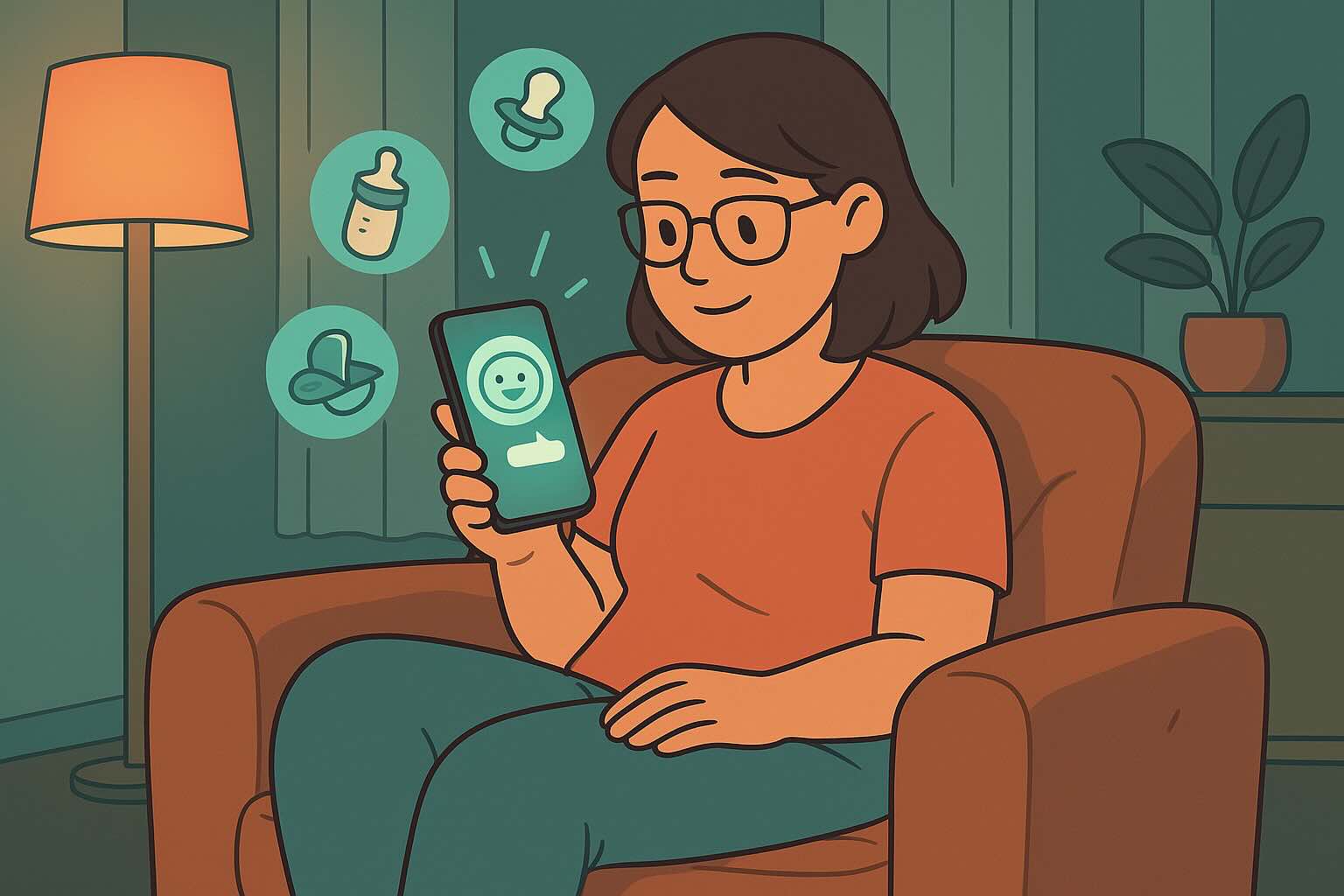
Challenging Moments Support
Access step-by-step parenting strategies, quick tips, and age-specific guidance for difficult situations when you need it most.
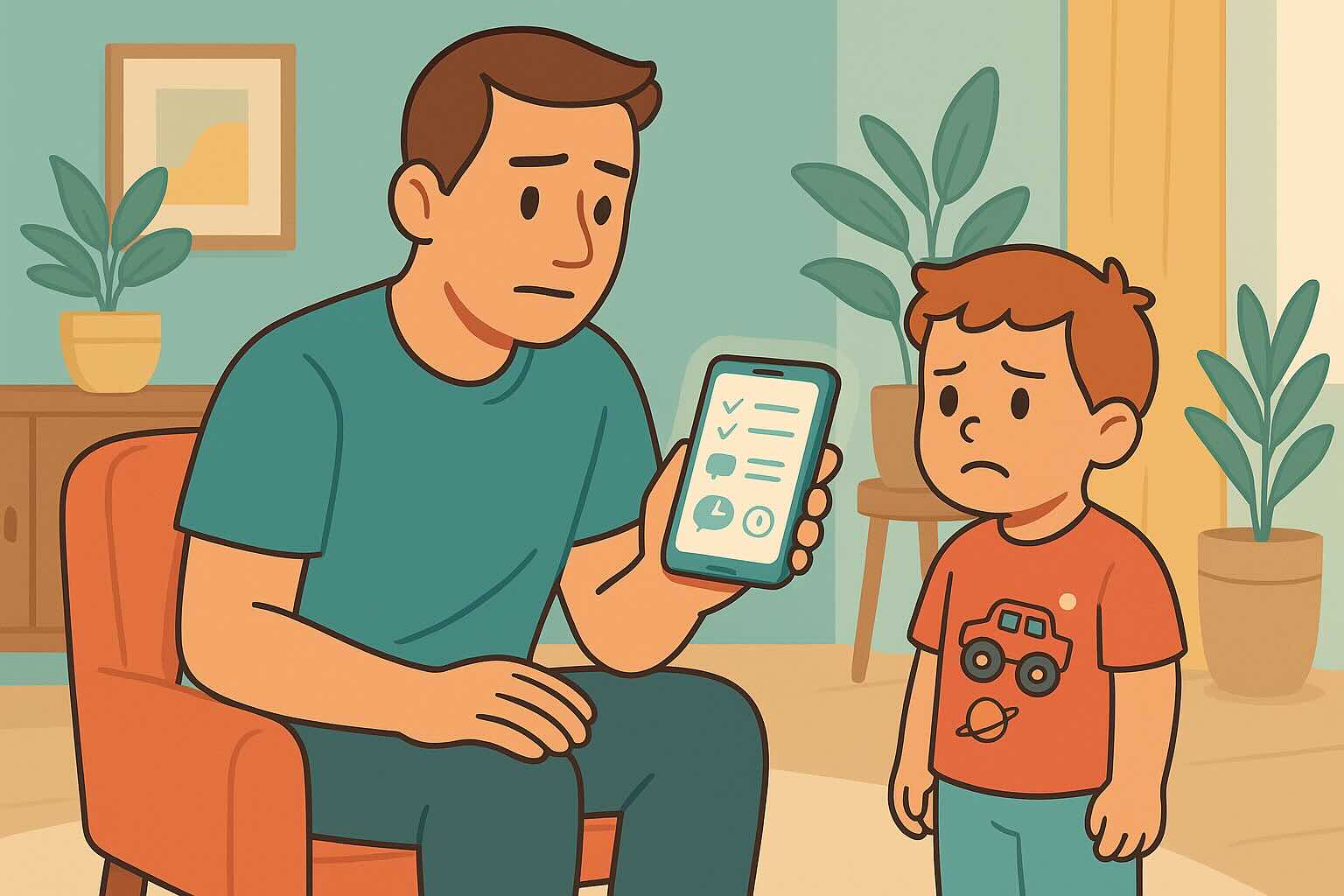
Complete Potty Learning Toolkit
Readiness assessments, age-specific strategies, and practical scripts to support your child's potty learning journey.
Frequently Asked Questions
Need personalized support?
RootWise's AI coach can provide tailored strategies for your specific situation, available 24/7 when you need it most.
Learn More About AI Coaching →